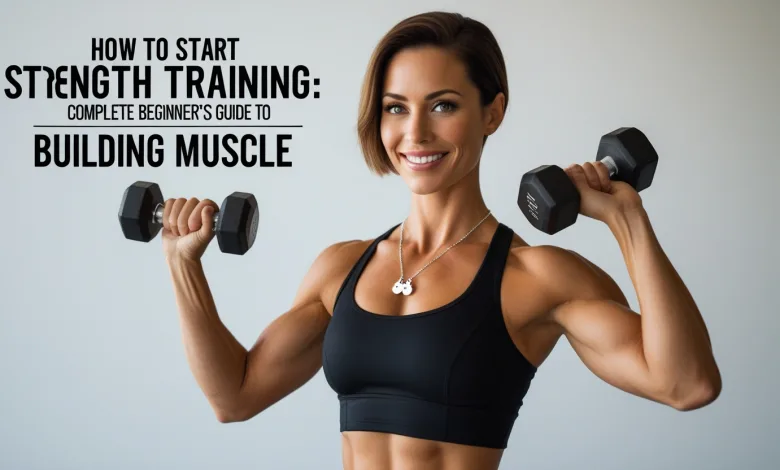How to Start Strength Training: Complete Beginner’s Guide to Building Muscle

Ready to embark on your strength training journey but feeling overwhelmed by conflicting advice? This comprehensive guide breaks down everything beginners need to know about building muscle effectively and safely, with expert tips to fast-track your progress from day one.
Introduction: Taking the First Step Toward Strength
Let’s face it — walking into a gym for the first time can feel about as comfortable as showing up to a black-tie event in flip-flops. Everyone seems to know what they’re doing except you, and those intimidating weight racks might as well be quantum physics equipment. But hey, we’ve all gotta start somewhere!
Strength training isn’t just about building bulging biceps or sculpting six-pack abs. It’s a transformative practice that enhances virtually every aspect of your health, from boosting metabolism and strengthening bones to improving mental health and increasing longevity. According to a study published in the British Journal of Sports Medicine, strength training reduces all-cause mortality by 23%, independent of aerobic exercise. That’s nothing to sneeze at!
In this comprehensive guide to how to start strength training, we’ll break down everything you need to know to begin your muscle-building journey with confidence. Whether you’re aiming to gain strength, lose weight, or simply feel more capable in your daily life, the principles we’ll cover will set you on the path to sustainable results.
The Science Behind Strength: Why Lifting Weights Works
Before diving into the nitty-gritty of workout routines, let’s demystify what’s actually happening when you strength train. Understanding the basics can keep you motivated when progress seems slow.
When you challenge your muscles through resistance training, you create microscopic tears in muscle fibers. Don’t worry — this isn’t a bad thing! Your body repairs these tears during rest periods, making the muscles stronger and larger in the process. This adaptation is your body’s way of preparing for future challenges.
This process, called hypertrophy, doesn’t happen overnight. According to research from the American College of Sports Medicine, visible muscle changes typically begin after 6-8 weeks of consistent training. The key word here is “consistent” — your body needs regular stimulus and adequate recovery to transform.
Strength training also triggers a cascade of hormonal responses that benefit your entire body. Testosterone, growth hormone, and insulin-like growth factor all increase during and after resistance exercise, creating an optimal environment for muscle growth and fat loss. Women, don’t worry about bulking up too much — the typical female hormonal profile means you’ll develop toned, strong muscles rather than massive bulk unless you’re specifically training and eating for size.
Essential Equipment: What You Actually Need (And What You Don’t)
Here’s some good news for your wallet: you don’t need fancy equipment to start strength training. While Instagram might have you believing otherwise, the basics will take you surprisingly far.
For home workouts, consider investing in:
- A set of adjustable dumbbells (more cost-effective than buying multiple pairs)
- A stability ball
- Resistance bands of varying tensions
- A yoga mat for floor exercises
That’s it! This simple setup allows for hundreds of effective exercises targeting every major muscle group. As you advance, you might consider adding a pull-up bar or kettlebells, but they’re not essential for beginners.
If you’re joining a gym, you’ll have access to a wider variety of equipment. Don’t let this overwhelm you! Start with free weights (dumbbells and barbells) before venturing into machine territory. Free weights engage more stabilizing muscles and generally provide more bang for your buck in terms of overall strength development. According to research in the Journal of Strength and Conditioning Research, exercises like free-weight squats activate significantly more muscle than their machine counterparts.
One piece of equipment worth investing in from day one: proper shoes. Look for flat-soled shoes with minimal cushioning for weight training. Those cushy running shoes might feel comfortable, but they create an unstable base for lifting. Brands like Converse Chuck Taylors are actually popular lifting shoes precisely because they’re flat and stable!
The Fundamentals: 5 Movements Everyone Should Master
Rather than jumping into complicated routines, focus first on mastering five fundamental movement patterns that form the foundation of strength training:
- The Squat: The king of lower body exercises, targeting quadriceps, hamstrings, glutes, and core.
- The Hip Hinge (deadlift variations): Strengthens the posterior chain, including lower back, glutes, and hamstrings.
- The Push (horizontal and vertical): Works chest, shoulders, and triceps through movements like push-ups and overhead presses.
- The Pull (horizontal and vertical): Targets back and biceps through rows and pull-up variations.
- The Carry: Simply walking while holding weights improves grip strength and core stability.
By focusing on these movement patterns rather than isolated muscle groups, you’ll develop functional strength that translates to real-world activities. Plus, compound movements like these burn more calories and stimulate more muscle growth than isolation exercises.
Let’s break down proper form for the squat as an example:
- Stand with feet shoulder-width apart, toes slightly turned out
- Brace your core and keep chest up
- Push hips back (imagine sitting in a chair)
- Lower until thighs are at least parallel to floor (if mobility allows)
- Drive through heels to return to standing
- Keep knees tracking over toes throughout movement
The most common mistake? Letting the knees cave inward or the heels lift. Practice first with bodyweight only, and add resistance only when your form is solid. According to research in the International Journal of Sports Physical Therapy, mastering proper form reduces injury risk by up to 60% and increases exercise effectiveness.
Creating Your First Workout Routine: A Blueprint for Success
Now for the fun part — putting together your first workout plan! As a beginner, you’ll benefit most from a full-body approach rather than the body-part splits (like “chest day” or “leg day”) that advanced lifters might use.
Here’s a simple, effective routine you can perform 2-3 times per week, with at least one day of rest between sessions:
- Goblet Squat: 3 sets of 10-12 reps
- Dumbbell Row: 3 sets of 10-12 reps per side
- Push-up (modified if needed): 3 sets of 8-10 reps
- Romanian Deadlift: 3 sets of 10-12 reps
- Dumbbell Shoulder Press: 3 sets of 10-12 reps
- Plank: 3 sets, hold for 20-30 seconds
This routine hits all major muscle groups and movement patterns. As a beginner, your goal is to practice movement patterns and build a base of strength. Start with lighter weights than you think you need, and focus on perfect form.
How do you know when to increase weight? Follow the “two-rep rule”: When you can perform two more reps than prescribed with good form, it’s time to increase the weight slightly (about 5-10%). This progressive overload principle is essential for continued improvement.
Remember, consistency trumps intensity for beginners. It’s better to do three moderate workouts every week than to crush yourself with one brutal session and skip the rest of the week because you’re too sore to move!
Nutrition Fundamentals: Fueling Your Strength Journey
You’ve heard the saying that “abs are made in the kitchen” — and while that’s somewhat oversimplified, nutrition absolutely plays a critical role in your strength training results.
For beginners, focus on these nutritional priorities:
- Protein intake: Aim for 1.6-2.2g per kg of bodyweight daily. Protein provides the building blocks for muscle repair and growth. According to a meta-analysis published in the British Journal of Sports Medicine, this range optimizes muscle protein synthesis for strength trainers.
- Adequate calories: Slight caloric surplus (200-300 calories above maintenance) for muscle gain, slight deficit for fat loss while maintaining muscle. Either way, extreme deficits will hamper your progress.
- Meal timing: While not as crucial as overall intake, having protein-rich meals every 3-4 hours optimizes muscle protein synthesis.
- Hydration: Even mild dehydration reduces performance by up to 10%. Aim for clear or light yellow urine as an indicator of good hydration status.
What about supplements? As a beginner, you can make excellent progress without any supplements whatsoever. If you struggle to meet your protein needs through whole foods, a quality protein powder can be helpful. The only other supplement with substantial research backing is creatine monohydrate, which helps increase strength and power output. Everything else is optional and often unnecessary for beginners.
Don’t fall into the trap of overthinking nutrition. Perfect is the enemy of good, and consistency with the basics will take you further than complexity you can’t sustain.
Recovery: The Missing Link in Most Training Programs
Here’s where most beginners go wrong: they focus all their energy on workout intensity but neglect recovery. Yet it’s during recovery, not during the workout itself, that your body actually builds muscle and strength.
Essential recovery components include:
- Sleep: Aim for 7-9 hours of quality sleep. According to research in the International Journal of Sports Medicine, sleep deprivation significantly impairs muscle recovery and growth.
- Rest days: Allow at least 48 hours before training the same muscle group again. As a beginner, full-body workouts with rest days in between work well.
- Active recovery: Light movement like walking, swimming, or yoga on rest days improves blood flow and accelerates recovery.
- Stress management: Chronic stress elevates cortisol, which can impair recovery and promote fat storage. Find stress-reduction techniques that work for you.
One recovery tool worth investing in: a foam roller. This inexpensive device helps release muscle tension and improve mobility. Spend 5-10 minutes foam rolling after workouts, focusing on tight areas.
Pay attention to your body’s signals. Persistent joint pain differs from normal muscle soreness and may indicate a need to modify your technique or reduce weight. The “no pain, no gain” mentality leads many beginners straight to injury.
Common Beginner Mistakes and How to Avoid Them
Let’s talk about the pitfalls that trip up many strength training newcomers:
Ego lifting: Using weights that are too heavy and sacrificing form is the fast track to Injury City. Leave your ego at the door and focus on technique first.
Program hopping: Constantly switching between different workout plans prevents you from mastering any one approach. Stick with a program for at least 8-12 weeks before evaluating its effectiveness.
Majoring in the minors: Obsessing over the “perfect” grip width or rep tempo while neglecting consistency and progressive overload. The fundamentals matter far more than the details.
Comparing yourself to others: Everyone starts somewhere, and genetics play a significant role in how quickly people progress. According to research in the Journal of Applied Physiology, genetic factors can influence muscle growth response to resistance training by up to 65%. Focus on competing with yourself, not others.
Neglecting mobility work: Skipping warm-ups and mobility exercises might save time in the short term but leads to limitations and injuries in the long run. Spend 5-10 minutes before each workout on dynamic mobility exercises specific to the movements you’ll be performing.
Remember: mistakes are part of the learning process. Be patient with yourself and view setbacks as valuable feedback rather than failures.
Tracking Progress: Meaningful Metrics Beyond the Scale
When you’re new to strength training, progress comes quickly at first—but how do you know you’re moving in the right direction? While the scale can provide some information, it’s just one of many metrics worth tracking.
Consider monitoring:
- Strength increases: Keep a workout log of weights used and reps completed
- Measurements: Monthly measurements of chest, waist, hips, arms, and thighs
- Progress photos: Take photos in consistent lighting and poses every 4 weeks
- Performance metrics: Can you climb stairs more easily? Carry groceries without fatigue? These functional improvements matter!
- Energy levels and mood: Strength training should enhance your overall wellbeing
One particularly effective method is recording your workouts (weight, sets, and reps) in a notebook or app. According to a study in the Journal of Strength and Conditioning Research, trainees who log their workouts consistently show 27% better progress than those who don’t.
Don’t expect linear progress—strength development typically follows a pattern of rapid initial gains followed by smaller, more gradual improvements. This is normal! Celebrate the small victories along the way.
When and How to Progress Your Training
After 8-12 weeks of consistent training, your body will adapt to your initial routine. This is the perfect time to introduce new challenges to continue making progress.
Ways to progress your training include:
- Increasing weight: The most straightforward progression
- Adding volume: More sets or reps with the same weight
- Decreasing rest periods: Making workouts more metabolically challenging
- Increasing movement complexity: Progressing from supported to unsupported movements (e.g., machine chest press → bench press → push-up)
- Adding training days: Moving from 2-3 to 3-4 sessions per week
Don’t implement all these changes at once! Pick one variable to modify, then give your body 2-3 weeks to adapt before changing another aspect.
This is also a good time to consider splitting your full-body routine into upper/lower splits or push/pull/legs patterns, allowing more volume for each muscle group while maintaining adequate recovery.
According to research from the Journal of Strength and Conditioning Research, beginners continue seeing optimal results from full-body training for about 6 months before more split routines become advantageous. Don’t rush this progression—master the basics first.
Frequently Asked Questions
How long should my workouts last as a beginner?
Quality trumps quantity here. A focused 45-minute session is more effective than a distracted 90-minute workout. Including warm-up and cool-down, aim for 45-60 minutes. Research from the Journal of Strength and Conditioning Research suggests that natural hormone responses start to decline after about 60 minutes of resistance training.
Will strength training make women “bulky”?
This common concern is largely unfounded. Women typically have about 15-20 times less testosterone than men, making significant bulking difficult without specific training, nutrition, and sometimes supplementation aimed at maximizing size. Strength training is more likely to create a toned, defined appearance for most women. According to research in the Journal of Strength and Conditioning Research, women actually respond better to strength training in terms of relative strength gains compared to men.
Is it better to train in the morning or evening?
The best time is the time you’ll stick with consistently! That said, research shows slight advantages to afternoon/evening training for strength performance due to natural circadian rhythm effects on body temperature and hormone levels. According to a meta-analysis in Sports Medicine, strength performance is typically 3-7% better in the evening compared to morning. However, consistency matters far more than timing.
How much should I be lifting as a beginner?
Start lighter than you think necessary and perfect your form first. For most beginners, that means starting with very light dumbbells (5-10 lbs for women, 10-20 lbs for men) or even just bodyweight for compound movements. As a very general guideline, aim to use weights that make the last 2-3 reps challenging but still allow you to maintain proper form.
What should I eat before and after workouts?
Pre-workout, focus on easily digestible carbohydrates and moderate protein about 1-2 hours before training (e.g., banana with yogurt). Post-workout, aim for a combination of protein (20-30g) and carbohydrates within 1-2 hours. Research from the Journal of the International Society of Sports Nutrition indicates that the “anabolic window” is wider than previously thought, so don’t stress if you can’t eat immediately after training.
Final Thoughts: Your Strength Journey Starts Now
Starting strength training is like planting a tree — the best time was years ago, the second-best time is today. The journey of building strength isn’t just about physical transformation; it’s about developing discipline, resilience, and confidence that spill over into every area of life.
Remember that consistency beats perfection every time. The people who see the best results aren’t necessarily those with the most knowledge or the fanciest gym memberships — they’re the ones who show up, week after week, month after month.
Will there be challenges? Absolutely. Will progress sometimes seem frustratingly slow? You bet. But that’s all part of the process. Every single person you see lifting impressive weights in the gym started right where you are now.
So grab those dumbbells, perfect your form, and embrace the journey ahead. Your future stronger self will thank you for taking that first step today.





